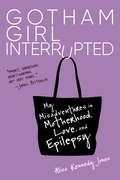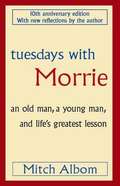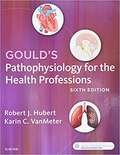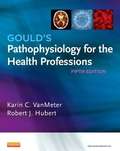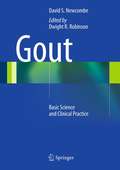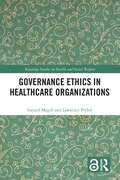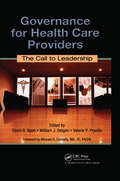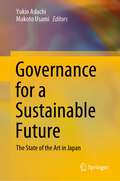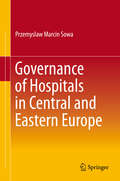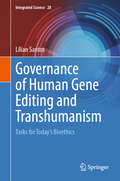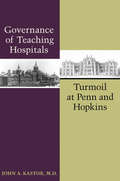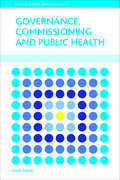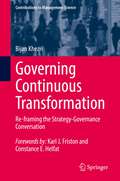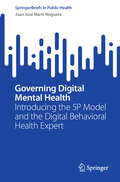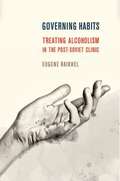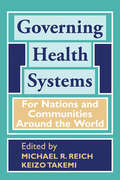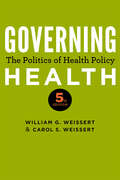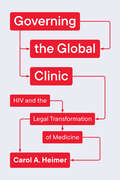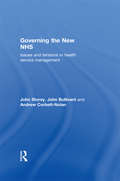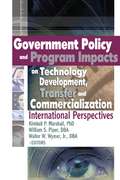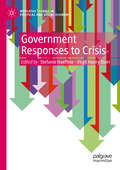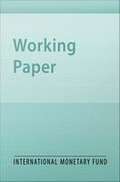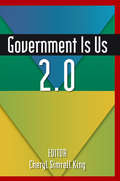- Table View
- List View
Gotham Girl Interrupted: My Misadventures in Motherhood, Love, and Epilepsy
by Alisa Kennedy JonesFor readers of Nora Ephron, Tina Fey and Jenny Lawson, Gotham Girl Interrupted offers a hilarious, heartfelt, and fiercely candid memoir about life as a hapless writer, single parent, impassioned city girl, and epileptic."Smart, harrowing, heart-warming, and very funny." --James PattersonSmart stand-up comedy about the power of falling down, Gotham Girl Interrupted is loaded with brash truths and laugh-out-loud moments about the epileptic age and culture in which we all live. It's also a dispatch from the frontlines of neurodiversity. Above all, it's about the battle for becoming who you are supposed to be and finding your tribe--no matter how much flopping around on the ground and wetting yourself you have to do to get there.With wit and humility, Alisa Kennedy Jones chronicles her experiences after a diagnosis of ecstatic epilepsy (also suffered by Dostoevsky, Van Gogh, Da Vinci and Agatha Christie). Beginning with the first in a series of terrifying yet beautiful grand mal seizures, which she likens to "swallowing a bolt of lightning," each seizure leaves her with what Zen Buddhists sometimes refer to as a "beginner's mind"--a vast, open expanse of headspace, coupled with a creative euphoria. It's a state that renders you less encumbered by everything you've already learned, but also challenged by having to relearn some of the more basic aspects of daily life.
Gotham Tragic
by Kurt WenzelCity restaurant is the hottest spot in Manhattan, the place where power meets ambition in an atmosphere rich with libidinous promise. Actors, agents, politicians, athletes, and Wall Street honchos jam the restaurant nightly, dealing, being seen, and, often, making their way into the next day's headlines. At the center of it all is City's most dedicated patron, Kyle Clayton. Kyle once wrote a novel that defined a generation, then parlayed that success into a decade of well-reported debauchery. Now he has shocked the literary world by falling in love with a Muslim woman and, more shocking still, converting to Islam. The idea of Kyle abstaining from any pleasure is a solar-plexus blow to New York nightlife. But abstention and New York are words that were never meant to be in the same sentence. Before Gotham Tragic is over, Clayton's new marriage unravels; the super-rich owner of City rides his success to a higher plane of hubris and faces the risk of incarceration; a waitress who graced one of Kyle's wilder nights returns to haunt his days; a Muslim doorman contemplates carrying out a fatwa against Kyle, who has betrayed his new faith in an irreverent short story; and everyone comes together at the New Year's Eve party of the century - at City, of course - in a frenzy of criminal indictments, misplaced emotions, lechery, squandered wealth, and the recognition that sometimes love is worth sacrifice.
Gould's Pathophysiology For The Health Professions
by Robert J. HubertLearn the essential concepts of major diseases/disorders and disease processes. Gould’s Pathophysiology for the Health Professions, 6th Edition is a concise, easy-to-understand introduction to the fundamentals of pathophysiology. Continuing in its well-known tradition of readability and vivid, full-color illustrations, the text is updated with the latest research and trends in human disease. Disorders are described by body system, with coverage of the interactions between systems, and special features help you to apply the material to real-life situations. No matter which healthcare field you may enter, this book provides solid preparation for the conditions you may encounter in clinical practice.
Gould's Pathophysiology for the Health Professions (Fifth Edition)
by Karin C. Vanmeter Robert J. HubertThis book provides an introduction to pathophysiology for students in a variety of academic programs and describes major disorders as well as selected additional diseases with the intention of providing information on a broad spectrum.
Gout
by Dwight R. Robinson David S. NewcombeGout: Basic Science and Clinical Practice is a thoroughly researched comprehensive text which covers all important aspects of gout, including its genetics, pathophysiology, diagnosis, and management. Gout is probably the most common rheumatic disease after osteoarthritis and is becoming more common with the prevalence of the metabolic syndrome in the US, and in many other countries. Only about 10% of patients with gout are treated by rheumatologists and this often leads to inadequate diagnosis and treatment in general medical practice. Written by an expert in the field this book is valuable reference for rheumatologists and others in the medical profession who are interested in understanding and managing this important disease.
Governance Ethics in Healthcare Organizations (Routledge Studies in Health and Social Welfare)
by Gerard Magill Lawrence PrybilDrawing on the findings of a series of empirical studies undertaken with boards of directors and CEOs in the United States, this groundbreaking book develops a new paradigm to provide a structured analysis of ethical healthcare governance. Governance Ethics in Healthcare Organizations begins by presenting a clear framework for ethical analysis, designed around basic features of ethics – who we are, how we function, and what we do – before discussing the paradigm in relation to clinical, organizational and professional ethics. It goes on to apply this framework in areas that are pivotal for effective governance in healthcare: oversight structures for trustees and executives, community benefit, community health, patient care, patient safety and conflicted collaborative arrangements. This book is an important read for all those interested in healthcare management, corporate governance and healthcare ethics, including academics, students and practitioners.
Governance for Health Care Providers: The Call to Leadership
by David B. Nash William J. Oetgen Valerie P. Pracilio Michael D. ConnellyMedical professionals who serve on the boards of private, nonprofit institutions often do so with much more diligence than knowledge. Very little material exists to cover the range of issues that are so vital at a time when health care institutions face patient overloads, budget shortages, and calls for reform. Written by leading health care adv
Governance for a Sustainable Future: The State of the Art in Japan
by Yukio Adachi Makoto UsamiAlthough the expression “responsibility to future generations” is firmly established in public and political vocabulary, its operational meaning and practice are inadequately understood and yet to be systematically evaluated. Moreover, the term has not been successfully translated into viable ethical and theoretical concepts that can guide public policies and actions. How can the modes of governance and established policy priorities become compatible with the well-being of future generations? The primary objective of this book is to identify the conditions of and obstacles to governance for a sustainable future, or future-regarding governance. Governance concerns steering a society over extended periods of time, not responding to particular policy issues. The ideas and strategies proposed by contributors in this book to establish future-regarding governance are based on the theoretical and empirical analyses of the major long-term problems facing advanced democracies in general, and Japan in particular. Japan is an interesting case indeed. Relatively poor climate policy, rapidly decreasing birth rate, aging population, extensive public debt, prolonged economic recession, healthcare and pension systems that urgently require redesigning, hollowing-out of industries and subsequent loss of jobs, deteriorating infrastructures, increasing nuclear waste, and intensifying social polarization have caused a decline in people’s trust in the government and democratic processes. Currently, Japanese citizens are widely circulating their doubts about the social system’s sustainability. This book comprises two parts. In Part I, authors from various disciplinary backgrounds examine the idea of governance for a sustainable future from theoretical perspectives. This part discusses issues associated with future-regarding governance that are wicked in nature, such as the philosophical/ethical foundation on which to base the idea of governance for a sustainable future, major impediments to the development of future-regarding governance, and the modes of thinking and action required by leaders and citizens to realize such governance. Chapters in Part II largely focus on the state of long-term governance in Japan. This part uses empirical and in-depth analyses with cross-sectoral and cross-national policy perspectives to identify the state of future-regarding governance in various policy fields and major sectors or organizations mainly in Japan, while also examining strategies and measures to improve their performance. From this perspective, Western democracies and weak democratic regimes elsewhere will be provided with valuable lessons to avoid fatal policy mistakes, thereby improving future-oriented governance worldwide. By combining theoretical discussions on far-reaching issues and empirical analyses of Japanese cases, the book will shed a new light on governance for a sustainable future.
Governance of Hospitals in Central and Eastern Europe
by Przemyslaw Marcin SowaThis book presents a novel view of healthcare system transition in post-communist countries. It is the first region-wide comparative study of hospital governance in Eastern Europe. Comprehensive new material shows the evolution and significance of governance, complementing recent publications on the topic from industrialised countries. Throughout the book, governance is described and substantiated as a major component that, together with provider payment mechanisms, defines the hospital sector's operations. This view subscribes to the economists' growing appreciation of extra-financial aspects in the discussion of incentives and regulation of healthcare markets. In particular, the book explains how governance arrangements may affect the outcomes of healthcare financing reforms, and should thus be seen as a critical determinant of their success or failure. This new model of thinking about healthcare system transition emerges from an analysis of 22 countries over the course of two decades. While the primary focus of the study is on developing the hospital sector, an extensive background chapter provides a standalone introduction to the dynamically changing landscape of healthcare in Eastern Europe and an overview of the various problems and challenges the region is facing. Practitioners, policy-makers, academics and students interested in Eastern European healthcare systems, their origins, current status and ways forward, will appreciate the book's reflections on the problem complexity, the clarity of its concepts, and its accessible style of presentation.
Governance of Human Gene Editing and Transhumanism: Tasks for Today’s Bioethics (Integrated Science #28)
by Lílian SantosAre there any commonalities between Transhumanism and the WHO framework for global governance of human genome editing? If yes, what are they and what are the implications for Bioethics? To find possible common themes, the author applied the reflective thematic analysis (RTA) method to a set of texts on Transhumanism and a set of texts on the global governance of human genome editing. The selected transhumanist texts were the three documents Humanity+, the former World Transhumanist Association, calls the &“original documents on Transhumanism&” (The Transhumanist Declaration, Transhumanist FAQ 3.0, The Transhumanist Manifesto v.4). The selected texts to represent the global governance of human genome editing were the three documents published by WHO on the topic in 2021, the only plan for the global governance of this biotechnology to date (Human genome editing: a framework for governance, Human genome editing: recommendations, Human genome editing: position paper). As a result of the application of the RTA method to the selected texts, the author presents and explains three common themes. What does this mean for our society? What are the implications of the current situation? What are the tasks for Bioethics? There are emerging questions on the human condition and new concerns to be addressed by Bioethics, such as the do-it-yourself mentality. The limitations of &“therapy vs. enhancement&” ask for serious work on a better bioethical paradigm. This book analyses the object, intentions, and circumstances of enhancement in general and recommends the principle of proportionality. The author questions the predominant values and propose a refinement to some conceptions of autonomy, protection, and equality. Finally, this book offers key elements for the bioethical evaluation of each type of human genome editing. Recognising the current situation and working on the identified tasks has become crucial for contemporary Bioethics.
Governance of Teaching Hospitals: Turmoil at Penn and Hopkins
by John A. KastorWhat forces lead to changes in governance among medical schools and their associated teaching hospitals? To what extent do such changes affect how well those schools and hospitals do their work? In this book, John A. Kastor, M.D., focuses on the academic medical centers of the University of Pennsylvania and the Johns Hopkins University, two institutions that underwent dramatic change in governance during the late 1990s.Drawing on extensive interviews with more than three hundred administrators, physicians, and other medical professionals at Penn, Hopkins, and elsewhere, Kastor identifies the factors that influenced changes in governance at these two institutions. Chief among these, he finds, are structure, personality conflicts, and current events. This book will be of interest to administrators of teaching hospitals as well as professionals in health policy and management.
Governance, Commissioning and Public Health (Evidence for Public Health Practice)
by Linda MarksDrawing on in-depth case studies across England, this book argues that governance and population health are inextricably linked. Using original research, it shows how these links can be illustrated at a local level through commissioning practice related to health and wellbeing. Exploring the impact of governance on decision- making, Governance, commissioning and public health analyses how principles, such as social justice, and governance arrangements, including standards and targets, influence local strategies and priorities for public health investment. In developing ‘public health governance’ as a critical concept, the study demonstrates the complexity of the governance landscape for public health and the leadership qualities required to negotiate it. This book is essential reading for students, academics, practitioners and policy-makers with an interest in governance and decision-making for public health.
Governing Continuous Transformation: Re-framing the Strategy-Governance Conversation (Contributions to Management Science)
by Bijan KhezriThis book transposes the ‘free-energy principle’, as espoused by the neuroscientist Karl Friston, to strategic governance, and forming the new concept of Free-Energy Governance (FEG). This concept lays the foundation for a new logic of governing continuous transformation. In addition to guiding the structure, cognition, and capabilities of success in strategic renewal, FEG provides a systematic and practice-relevant approach to predicting a firm’s potential for entropy.Using this new concept, the author shows that the success of continuous strategic renewal and business innovation, elements crucial for firm survival, are determined by the triplet of a firm’s structure, cognition, and dynamic board capabilities. “How to govern large organizations in times of high uncertainty and permanent change? To answer this pressing question, … Bijan Khezri has been the first to apply [the free energy] principle to management science … This book is an eyeopener for every reflective leader.¨ Professor Oliver Gassmann, Director of the Institute of Management and Technology, University of St. Gallen “I really enjoyed reading this book. It was both exciting and reassuring to see how the same fundamental ideas can be found in fields as disparate as nonequilibrium steady-state physics and theories of governance.” Professor Karl. J. Friston; Director of the Wellcome Centre for Human Neuroimaging “Using a term often applied to best-selling novels, ‘it is a page turner’ in which I learned something new in every chapter! Every board member, all executives and scholars interested in strategic leadership and governance must read this book if they wish to remain relevant in the coming transformational decades.” Michael A. Hitt University Distinguished Professor Emeritus, Mays Business School, Texas A&M University Former President, Academy of Management, and former Editor, Academy of Management Journal "We could not ask for a better author to initiate this new conversation in the board research community and convey its merits to the world of board practice." Martin HilbProfessor Emeritus, University of St. Gallen Founder and Managing Partner, International Board Foundation and President of Swiss Institute of Directors “Set against a wide swath of literature, the book impressively makes the case for a new logic of strategic renewal in which the board of directors plays a central role.” Professor Constance E. Helfat, Tuck School of Business at Dartmouth
Governing Digital Mental Health: Introducing the 5P Model and the Digital Behavioral Health Expert (SpringerBriefs in Public Health)
by Juan José Martí-NogueraThis book presents a bold governance blueprint for an era in which mental health systems face a historic transition: as care delivery becomes increasingly shaped by code, platforms, and predictive algorithms, new governance frameworks are needed to protect equity, ethics, and human-centered leadership. At the core of this blueprint is the 5P Model – Predictive, Preventive, Personalized, Participatory, and Precision-based – a transformative framework for building equitable, effective behavioral health systems in the age of AI. The book introduces the Digital Behavioral Health Expert (DBHE), a new professional role designed to bridge clinical care, policy systems, and digital infrastructure. Unlike traditional mental health models that focus on professional interaction alone, the DBHE enables coordination across platforms, stakeholders, and jurisdictions – turning governance into a strategic, ethical, and human-centered function. Designed for stakeholders across the ecosystem – policymakers shaping regulation, managers implementing care systems, clinicians navigating hybrid models, developers building ethical tools, and investors backing scalable solutions – this book equips each with strategic insight for a digitally governed future of mental health. "A timely vision for ethical, inclusive governance in digital mental health."— Professor Anil Thapliyal, Executive Director, eMental Health International Collaborative (eMHIC)
Governing Habits: Treating Alcoholism in the Post-Soviet Clinic
by Eugene RaikhelCritics of narcology—as addiction medicine is called in Russia—decry it as being "backward," hopelessly behind contemporary global medical practices in relation to addiction and substance abuse, and assume that its practitioners lack both professionalism and expertise. On the basis of his research in a range of clinical institutions managing substance abuse in St. Petersburg, Eugene Raikhel increasingly came to understand that these assumptions and critiques obscured more than they revealed. Governing Habits is an ethnography of extraordinary sensitivity and awareness that shows how therapeutic practice and expertise is expressed in the highly specific, yet rapidly transforming milieu of hospitals, clinics, and rehabilitation centers in post-Soviet Russia. Rather than interpreting narcology as a Soviet survival or a local clinical world on the wane in the face of globalizing evidence-based medicine, Raikhel examines the transformation of the medical management of alcoholism in Russia over the past twenty years.Raikhel's book is more than a story about the treatment of alcoholism. It is also a gripping analysis of the many cultural, institutional, political, and social transformations taking place in the post-Soviet world, particularly in Putin's Russia. Governing Habits will appeal to a wide range of readers, from medical anthropologists, clinicians, to scholars of post-Soviet Russia, to students of institutions and organizational change, to those interested in therapies and treatments of substance abuse, addiction, and alcoholism.
Governing Health Systems: For Nations and Communities Around the World
by Michael Reich Keizo TakemiGoverning Health Systems: For Nations and Communities Around the World examines the complex relationships between governance and performance in community and national health systems. Each chapter provides an in-depth case study, using both qualitative and quantitative methods, on health systems in many countries, including Uganda, Ghana, India, Zambia, Japan, Nigeria, Indonesia, Brazil, Palestine, and South Korea. The chapters were written by former Takemi Fellows, who were mid-career research fellows at the Harvard School of Public Health, and their colleagues. This case study approach yields important findings as well as contextual insights about the challenges and accomplishments in addressing governance issues in national and community health systems around the world. Health policymakers around the world are struggling to address the multiple challenges of governing health systems. These challenges also represent important themes for the research mission of the Takemi Program in International Health at the Harvard School of Public Health. This book is based on the program's thirtieth anniversary symposium held in October 2013 at Harvard. The studies presented in this book--deep examinations of illustrative examples of health system governance for communities and nations--contribute to our knowledge about global health and assist policymakers in dealing with the complex practical problems of health systems. In short, this book addresses central questions about governing health systems--and why governance matters.
Governing Health: The Politics of Health Policy
by William G. Weissert Carol S. WeissertGoverning Health examines health care policy from a political perspective, describing how Congress, the president, special interest groups, bureaucracy, and state governments help define health policy problems and find politically feasible solutions. William G. Weissert and Carol S. Weissert provide a highly readable and comprehensive synthesis of political science research on how government and private institutions affect the policy process. Extensive reviews of the policies that have governed health care since Lyndon Johnson's administration are capped off with a prognosis for the future. Updates to the fourth edition of Governing Health include - new examples and theory perspectives- recent statistics- discussion of the 2010 Obama health reform
Governing Health: The Politics of Health Policy
by William G. Weissert Carol S. WeissertHow do government and private interests shape the health policy process?In this classic text, William G. Weissert and Carol S. Weissert describe how government and private interests help define health policy. Under the Obama administration, the federal government took a broadened role in setting health policy and insurance regulations. But the succeeding Trump administration and a Republican congress threatened to dismantle the Affordable Care Act (ACA) and its core tenets. Chronicling these recent important changes, Governing Health explores the political science theory behind this and other major shifts in national health policy.In this thoroughly updated edition, the authors describe how party polarization, a virulent anti-government movement, populist presidential politics, and the demise of "regular order" in Congress shape and define a new approach to health policy. This revised edition also• offers a comprehensive synthesis of Obamacare, touching on everything from Accountable Care and Pay for Performance to insurance industry reforms • highlights the important role of social media in building opposition to universal coverage• tracks passage of the new Medicare physician payment reform, MACRA• analyzes presidential executive orders and administrative rulemaking in dismantling the Affordable Care Act• examines the implications of Supreme Court decisions on Medicaid expansion and state health policy • updates all statistics, charts, and tablesThis new edition of a highly respected book guides readers toward a deep understanding of modern health policy's complexities. Drawing on compelling current examples, Governing Health is a timely and essential book.
Governing the Global Clinic: HIV and the Legal Transformation of Medicine (Chicago Series in Law and Society)
by Carol A. HeimerA deep examination of how new, legalistic norms affected the trajectory of global HIV care and altered the practice of medicine. HIV emerged in the world at a time when medicine and healthcare were undergoing two major transformations: globalization and a turn toward legally inflected, rule-based ways of doing things. It accelerated both trends. While pestilence and disease are generally considered the domain of biological sciences and medicine, social arrangements—and law in particular—are also crucial. Drawing on years of research in HIV clinics in the United States, Thailand, South Africa, and Uganda, Governing the Global Clinic examines how growing norms of legalized accountability have altered the work of healthcare systems and how the effects of legalization vary across different national contexts. A key feature of legalism is universalistic language, but, in practice, rules are usually imported from richer countries (especially the United States) to poorer ones that have less adequate infrastructure and fewer resources with which to implement them. Challenging readers to reconsider the impulse to use law to organize and govern social life, Governing the Global Clinic poses difficult questions: When do rules solve problems, and when do they create new problems? When do rules become decoupled from ethics, and when do they lead to deeper moral commitments? When do rules reduce inequality? And when do they reflect, reproduce, and even amplify inequality?
Governing the New NHS: Issues and Tensions in Health Service Management
by John Storey John Bullivant Andrew Corbett-NolanThe new NHS is a very different organisation to the one set up 60 years ago. Two decades of reforms have introduced a market element, unprecedented transparency, patient choice, new incentives, devolved accountabilities and a host of new regulatory bodies. All these changes have made governance a crucial and contested issue in health care. Governing the New NHS makes sense of the new systems and will enable anyone interested in healthcare governance to navigate their way confidently through the maze. It describes, assesses and critiques the new governance arrangements. It examines how they are working in practice and how practitioners are responding. The book: explains current governance arrangements and explores related issues and tensions discusses the roles and interrelationships of boards and effective board practice offers a range of practical tools and frameworks. Each chapter is supplemented with expert witness statement written by leading practitioners in the health system. This practical book will be invaluable to all those interested in health governance, policy and management - whether academic, student or practitioner.
Government Policy and Program Impacts on Technology Development, Transfer, and Commercialization: International Perspectives
by Kimball Marshall William PiperIn recent decades, government-funded technologies have produced radar, microwave ovens, modern cell phone systems, the Internet, new materials for aircraft and motor vehicles, and new medical instrumentation. This first-of-its-kind book examines how access to technology is affected by government policies and government-sponsored programs.Government Policy and Program Impacts on Technology Development, Transfer, and Commercialization: International Perspectives provides an easy-to-read overview of the field and several studies serving as examples to guide government policymakers and private sector decision makers. This forward-looking book also forecasts the potential impacts of government regulation upon the field and presents provocative discussions of the ethical implications of the cross-cultural and cross-national challenges facing technologically developed nations in the global economy.This book reviews this broad field by first providing an overview of the goals of government technology policies and programs as well as of generic types of government technology programs. Next, it presents carefully selected studies that illustrate the potential impacts of government decisions upon marketing constraints, industry acceptance of regulatory requirements, economic development, gross domestic product, and the choices firms make when it comes to location, competitiveness, product development, and other factors. The final chapters explore ethical considerations from a global perspective. These chapters also explore the implications of these considerations in relation to the success of governmental and private sector technology transfer and commercialization programs. The macromarketing perspective taken by the contributors serves to ground the impacts of government technology policies and programs in practical implications for economic development, business productivity, and quality of life. The contributors to this unique collection share their expertise on government sponsorship of technology research, the impact of government regulation upon technology marketing and economic development, the effects of government policies on business practices, intellectual property rights, and much more.Government Policy and Program Impacts on Technology Development, Transfer, and Commercialization shows how evolving technology and government policy changes have affected: the commercialization of music-new media, piracy problems, consumer choices and costs, and changes in the radio and concert promotion industries the adoption of new household technology licensure requirements for telemedicine-with an essential overview of telemedicine plus examinations of relevant governmental regulations and potential applications patents, copyrights, trademarks, licensing, and proprietary information scrap tire disposal-new alternatives for a chronic waste disposal problem food product development state-owned enterprises-with a case study illustrating how a stagnant state-owned company quickly evolved into China&’s leading firm in the textile machinery field
Government Responses to Crisis (Mercatus Studies in Political and Social Economy)
by Virgil Henry Storr Stefanie HaeffeleWhen crises occur, citizens, media and policymakers alike expect government to respond and to take a leading role in recovery. Given the scale and scope of crises, whether natural (such as hurricanes, floods, and earthquakes), manmade (such as conflict and economic downturns), or often a combination of the two, governments are often seen as being in the best position to identify the problems, understand the circumstances, and direct action. They are also likely to be the entities that have adequate resources to devote to such large-scale efforts. Yet, governments are not spared from the effects of crises. They are composed of individuals who are impacted by disasters and face many of the same challenges in identifying needs, prioritizing action, and adjusting to changing circumstances. It is by no surprise that governments are also often scrutinized during and after crises. How, then, do we understand the capability of and proper role for governments to respond to crisis and to drive recovery? This edited volume—comprised of chapters by accomplished scholars and seasoned practitioners in disaster and crises studies and management, spanning multiple disciplines including sociology, economics, and public administration—examines the roles, expectations, and capabilities of government responses to crises. It gives an overview of the literature, provides lessons learned from both research and experience on the ground during crises, and puts forth a framework for understanding crisis management and subsequent policy implications. It will be of use to any scholars, students, practitioners or policymakers interested in learning from and better preparing for crises and responding when they do occur.
Government Responses to the COVID-19 Pandemic: Between a Rock and a Hard Place
by Olga ShvetsovaThis book examines how governments around the world responded to the health emergency created by the COVID-19 pandemic. Before vaccines became available, non-medical interventions were the main means to protect the public. Non-medical interventions were put in place by governments as public health policies. In every nation, politicians and governments faced a choice situation, and worldwide, they made different choices. Public health policies came at a price, in economic, social, and ultimately electoral costs to the political incumbents. The book discusses differences in governments’ policy efforts to mitigate the virus spread. The authors conduct in-depth analysis of country-cases from Africa, North and South America, Asia, and Europe. They also offer small-n- comparative analyses as well as report global patterns and trends of governments’ responsiveness to the medical emergency. It will appeal to all those interested in public policy, health policy and governance.
Government Spending on Health Care and Education in Croatia: Efficiency and Reform Options
by Etibar Jafarov Victoria GunnarssonA report from the International Monetary Fund.
Government is Us 2.0
by Cheryl Simrell KingThis book talks about the relationships amongst and between citizens and their governments, the possibilities of governing differently in ways that don't oppress, marginalize, or limit people, and about bringing different sensibilities to the practices of administration in US.
